生命周期
Vue 生命周期 和 生命周期的四个阶段
思考:
- 什么时候可以发送初始化渲染请求?(越早越好)
- 什么时候可以开始操作dom?(至少dom得渲染出来)
Vue生命周期:一个Vue实例从 创建 到 销毁 的整个过程。
生命周期四个阶段:① 创建 (初始化动态数据)② 挂载 (渲染模板)③ 更新 ④ 销毁
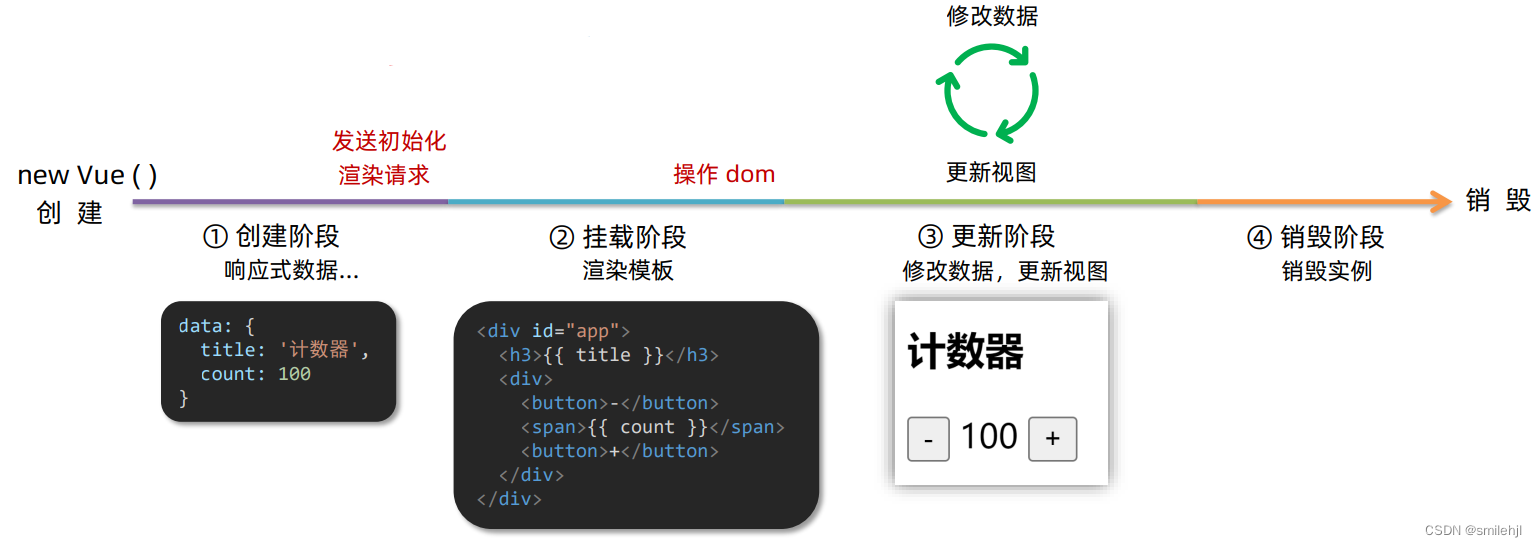
Vue 生命周期函数(钩子函数)
Vue生命周期过程中,会自动运行一些函数,被称为【生命周期钩子】→ 让开发者可以在【特定阶段】运行自己的代码。



<!DOCTYPE html>
<html lang="en">
<head><meta charset="UTF-8"><meta http-equiv="X-UA-Compatible" content="IE=edge"><meta name="viewport" content="width=device-width, initial-scale=1.0"><title>Document</title>
</head>
<body><div id="app"><h3>{{ title }}</h3><div><button @click="count--">-</button><span>{{ count }}</span><button @click="count++">+</button></div></div><script src="https://cdn.jsdelivr.net/npm/vue@2/dist/vue.js"></script><script>const app = new Vue({el: '#app',data: {count: 100,title: '计数器'},// 1. 创建阶段(准备数据)beforeCreate () {console.log('beforeCreate 响应式数据准备好之前', this.count)},created () {console.log('created 响应式数据准备好之后', this.count)// this.数据名 = 请求回来的数据// 可以开始发送初始化渲染的请求了},// 2. 挂载阶段(渲染模板)beforeMount () {console.log('beforeMount 模板渲染之前', document.querySelector('h3').innerHTML)},mounted () {console.log('mounted 模板渲染之后', document.querySelector('h3').innerHTML)// 可以开始操作dom了},// 3. 更新阶段(修改数据 → 更新视图)beforeUpdate () {console.log('beforeUpdate 数据修改了,视图还没更新', document.querySelector('span').innerHTML)},updated () {console.log('updated 数据修改了,视图已经更新', document.querySelector('span').innerHTML)},// 4. 卸载阶段beforeDestroy () {console.log('beforeDestroy, 卸载前')console.log('清除掉一些Vue以外的资源占用,定时器,延时器...')},destroyed () {console.log('destroyed,卸载后')}})</script>
</body>
</html>小黑记账清单
功能需求:
1. 基本渲染
2. 添加功能
3. 删除功能
4. 饼图渲染

<!DOCTYPE html>
<html lang="en"><head><meta charset="UTF-8" /><meta name="viewport" content="width=device-width, initial-scale=1.0" /><title>Document</title><!-- CSS only --><linkrel="stylesheet"href="https://cdn.jsdelivr.net/npm/bootstrap@5.1.3/dist/css/bootstrap.min.css"/><style>.red {color: red!important;}.search {width: 300px;margin: 20px 0;}.my-form {display: flex;margin: 20px 0;}.my-form input {flex: 1;margin-right: 20px;}.table > :not(:first-child) {border-top: none;}.contain {display: flex;padding: 10px;}.list-box {flex: 1;padding: 0 30px;}.list-box a {text-decoration: none;}.echarts-box {width: 600px;height: 400px;padding: 30px;margin: 0 auto;border: 1px solid #ccc;}tfoot {font-weight: bold;}@media screen and (max-width: 1000px) {.contain {flex-wrap: wrap;}.list-box {width: 100%;}.echarts-box {margin-top: 30px;}}</style></head><body><div id="app"><div class="contain"><!-- 左侧列表 --><div class="list-box"><!-- 添加资产 --><form class="my-form"><input type="text" v-model="name" class="form-control" placeholder="消费名称" /><input type="text" v-model.number="price" class="form-control" placeholder="消费价格" /><button type="button" class="btn btn-primary" @click="add()">添加账单</button></form><table class="table table-hover"><thead><tr><th>编号</th><th>消费名称</th><th>消费价格</th><th>操作</th></tr></thead><tbody><tr v-for="(item,index) in list" :key="item.id"><td>{{index+1}}</td><td>{{item.name}}</td><td :class="{ red: item.price>500}">{{item.price}}</td><td><a href="javascript:;" @click="del(item.id)">删除</a></td></tr></tbody><tfoot><tr><td colspan="4" class="red">消费总计: {{totalPrice.toFixed(2)}}</td></tr></tfoot></table></div><!-- 右侧图表 --><div class="echarts-box" id="main"></div></div></div><script src="https://cdn.jsdelivr.net/npm/echarts@5.4.0/dist/echarts.min.js"></script><script src="https://cdn.jsdelivr.net/npm/vue@2/dist/vue.js"></script><script src="https://cdn.jsdelivr.net/npm/axios/dist/axios.min.js"></script><script>/*** 接口文档地址:* https://www.apifox.cn/apidoc/shared-24459455-ebb1-4fdc-8df8-0aff8dc317a8/api-53371058* * 功能需求:* 1. 基本渲染* 2. 添加功能* 3. 删除功能* 4. 饼图渲染*/const app = new Vue({el: '#app',data: {list: [],name: '',price: null},computed: {totalPrice(){let total = this.list.reduce((sum,item)=>sum+item.price,0)return total}},methods: {async getList(){// 使用ajax发送请求const res = await axios.get('https://applet-base-api-t.itheima.net/bill',{params: {creator: 'jack'}})// console.log(res);this.list=res.data.data// console.log(this.list);//更新图表this.Chars.setOption({series: [{// data: [// { value: 1048, name: 'Search Engine' },// { value: 735, name: 'Direct' },// { value: 580, name: 'Email' },// { value: 484, name: 'Union Ads' },// { value: 300, name: 'Video Ads' }// ]data: this.list.map(item=>{//返回一个对象return {value: item.price, name: item.name}})}]})},async add(){if(!this.name){alert('请输入商品名称')return}if(typeof this.price!== 'number'){alert('请输入正确的价格')return}const res = await axios.post('https://applet-base-api-t.itheima.net/bill',{creator: 'jack',name: this.name,price: this.price})//重新渲染this.getList()//重置输入框this.name = ''this.price = null},async del(id){const res = await axios.delete(`https://applet-base-api-t.itheima.net/bill/${id}`)//重新渲染this.getList()}},// 在数据动态化后执行的钩子函数created(){//数据出初始化完成后,获取数据this.getList()},//在视图渲染完成后执行mounted(){//初始化echarts对象this.Chars = echarts.init(document.querySelector('#main'))this.Chars.setOption({// 标题title: {text: '消费账单列表',left: 'center'},// tooltip: {trigger: 'item'},// 小图标legend: {orient: 'vertical',left: 'left'},series: [{name: '消费账单',type: 'pie',radius: '50%',data: [{ value: 1048, name: 'Search Engine' },{ value: 735, name: 'Direct' },{ value: 580, name: 'Email' },{ value: 484, name: 'Union Ads' },{ value: 300, name: 'Video Ads' }],emphasis: {itemStyle: {shadowBlur: 10,shadowOffsetX: 0,shadowColor: 'rgba(0, 0, 0, 0.5)'}}}]})}})</script></body>
</html>
案例总结:

工程化开发入门
开发 Vue 的两种方式:
1. 核心包传统开发模式:基于 html / css / js 文件,直接引入核心包,开发 Vue。
2. 工程化开发模式:基于构建工具(例如:webpack ) 的环境中开发 Vue。

工程化开发 & 脚手架 Vue CLI
基本介绍:
Vue CLI 是 Vue 官方提供的一个全局命令工具。
可以帮助我们快速创建一个开发 Vue 项目的标准化基础架子。【集成了 webpack 配置】
好处:
1. 开箱即用,零配置
2. 内置 babel 等工具
3. 标准化
使用步骤:
1. 全局安装 (一次) :yarn global add @vue/cli 或 npm i @vue/cli -g
2. 查看 Vue 版本:vue --version
3. 创建项目架子:vue create project-name(项目名-不能用中文)
4. 启动项目: yarn serve 或 npm run serve(找package.json)
脚手架目录文件介绍 & 项目运行流程
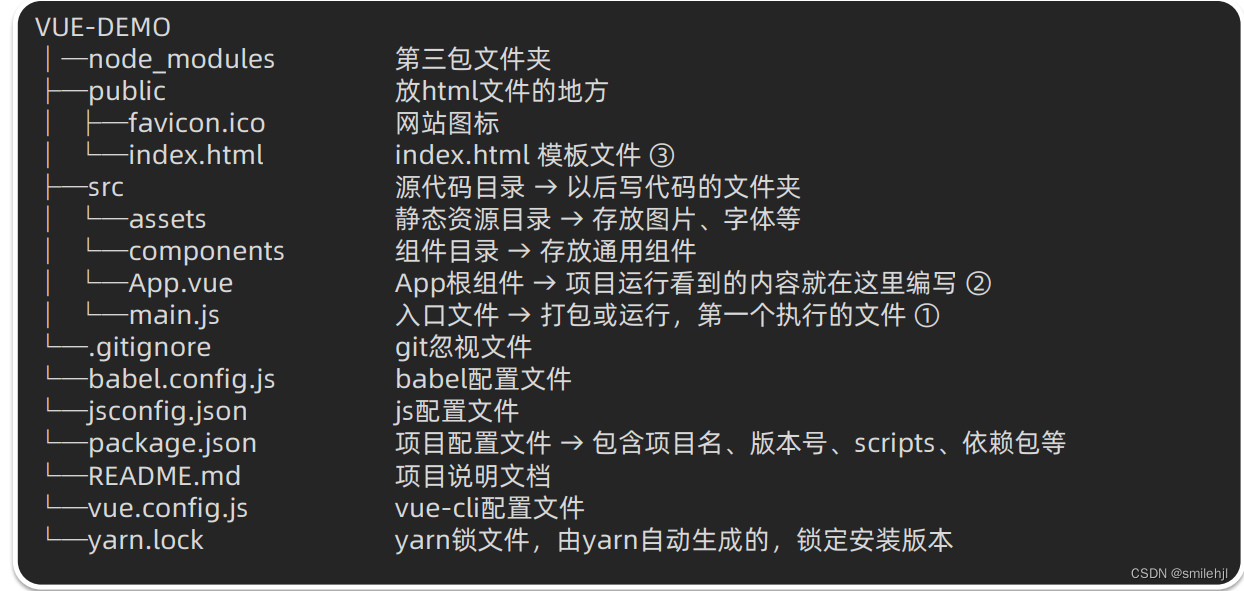

组件化开发 & 根组件
① 组件化:一个页面可以拆分成一个个组件,每个组件有着自己独立的结构、样式、行为。 好处:便于维护,利于复用 → 提升开发效率。
组件分类:普通组件、根组件。
② 根组件:整个应用最上层的组件,包裹所有普通小组件。


App.vue 文件(单文件组件)的三个组成部分
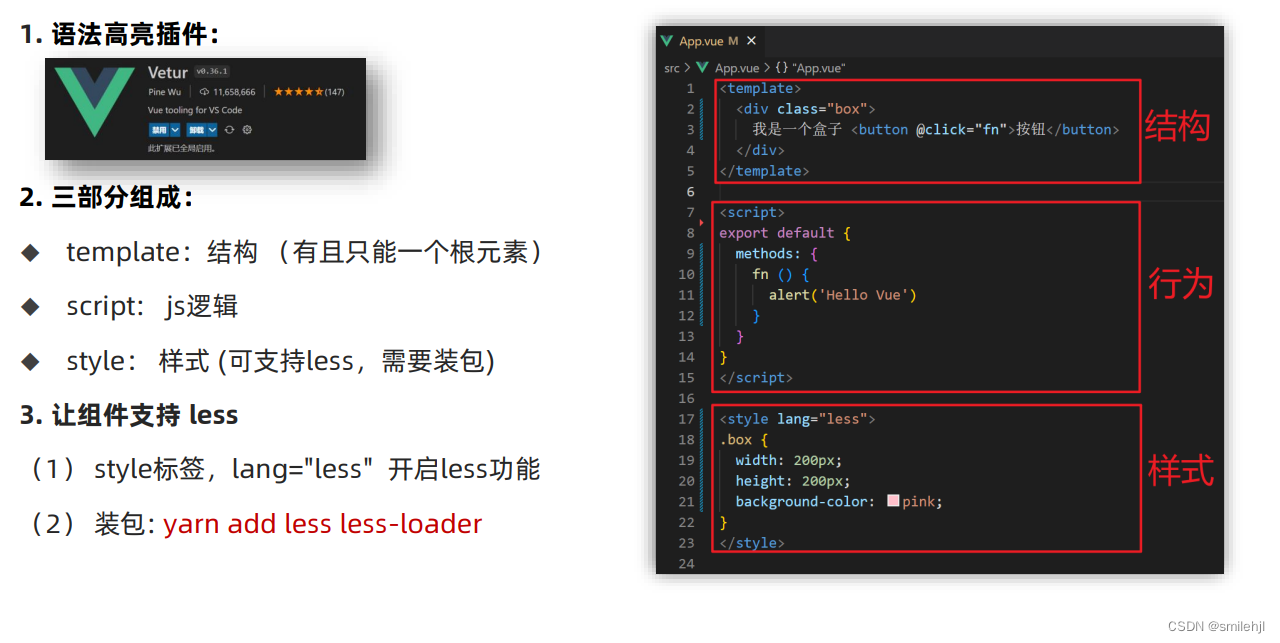
普通组件的注册使用
组件注册的两种方式:
1. 局部注册:只能在注册的组件内使用
① 创建 .vue 文件 (三个组成部分)
② 在使用的组件内导入并注册
2. 全局注册:所有组件内都能使用
局部注册
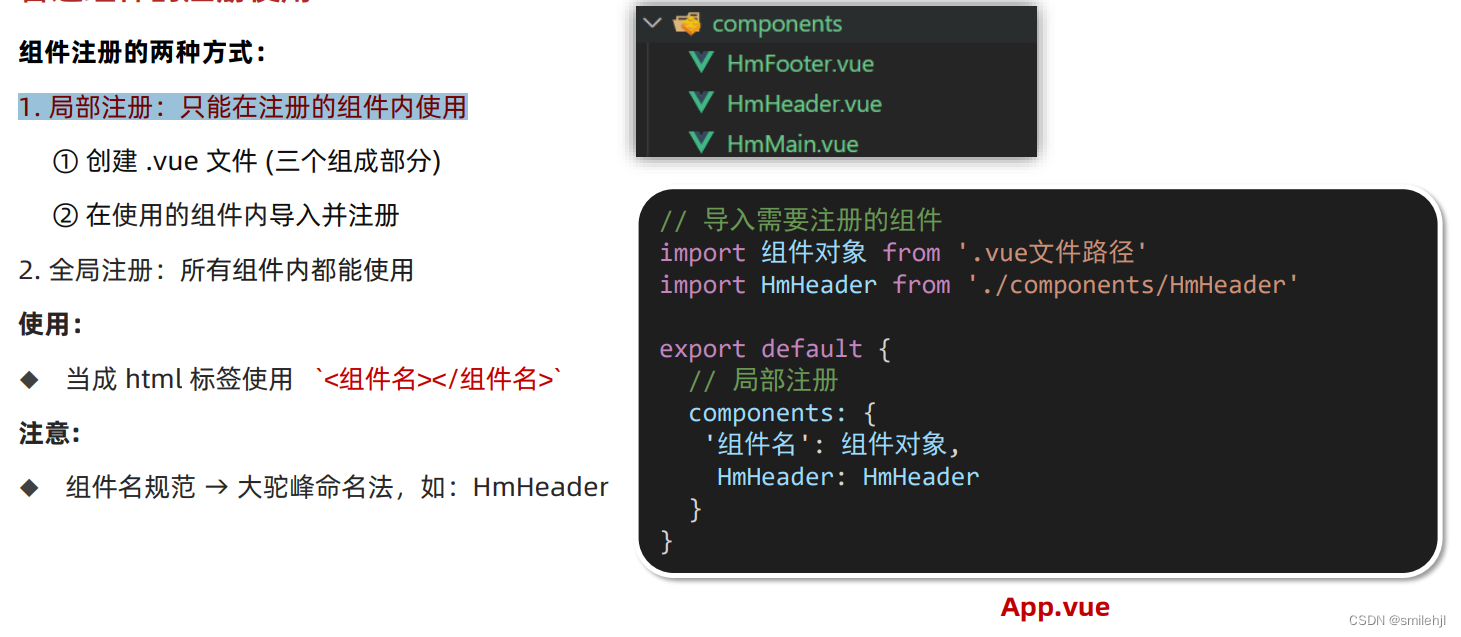
全局注册
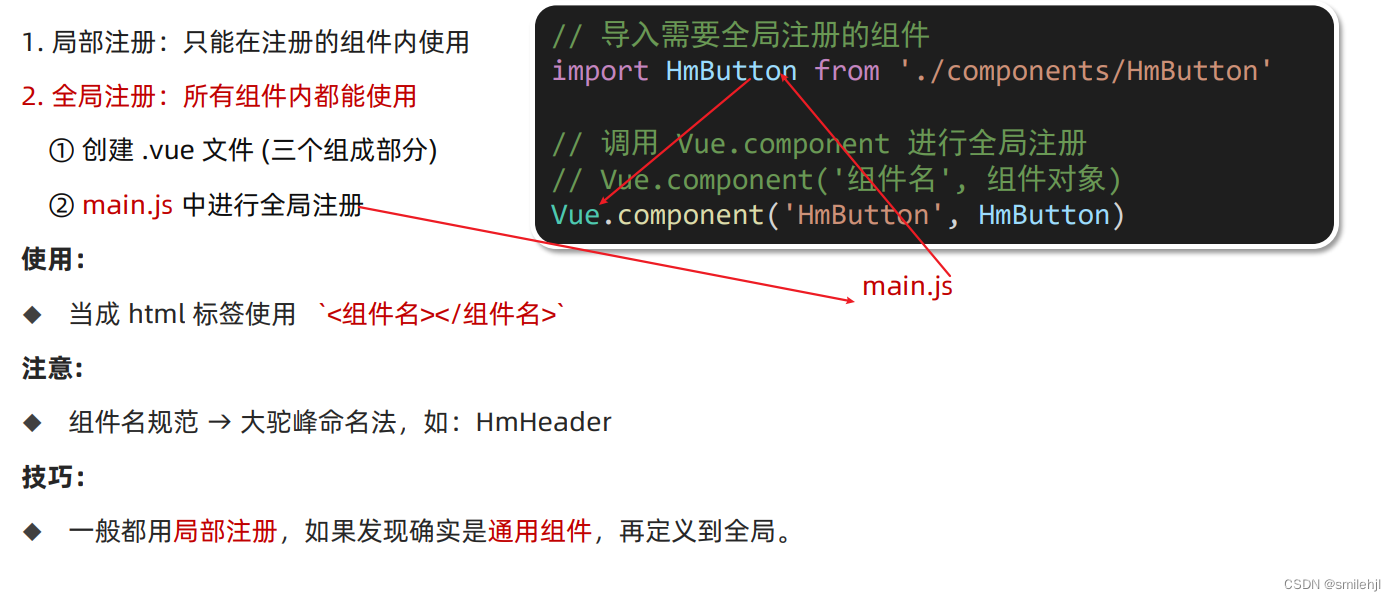
小结:
(1) 组件化:
页面可拆分成一个个组件,每个组件有着独立的结构、样式、行为
① 好处:便于维护,利于复用 → 提升开发效率。
② 组件分类:普通组件、根组件。
(2) 根组件:
整个应用最上层的组件,包裹所有普通小组件。
一个根组件App.vue,包含的三个部分:
① template 结构 (只能有一个根节点)
② style 样式 (可以支持less,需要装包 less 和 less-loader )
③ script 行为
两种注册方式:
① 局部注册:
(1) 创建.vue组件 (单文件组件)
(2) 使用的组件内导入,并局部注册 components: { 组件名:组件对象 }
② 全局注册:
(1) 创建.vue组件 (单文件组件)
(2) main.js内导入,并全局注册 Vue.component(组件名, 组件对象)
使用:
<组件名></组件名>
技巧:
一般都用局部注册,如果发现确实是通用组件,再抽离到全局。
综合案例:小兔鲜首页

页面开发思路:
1. 分析页面,按模块拆分组件,搭架子 (局部或全局注册)
2. 根据设计图,编写组件 html 结构 css 样式 (已准备好)
3. 拆分封装通用小组件 (局部或全局注册)
将来 → 通过 js 动态渲染,实现功能

》“水晶晶”和景物”数量提取66个)





)






)


C++的类型转换)

![[office] excel如何计算毛重和皮重的时间间隔 excel计算毛重和皮重时间间隔方法 #笔记#学习方法](http://pic.xiahunao.cn/[office] excel如何计算毛重和皮重的时间间隔 excel计算毛重和皮重时间间隔方法 #笔记#学习方法)
